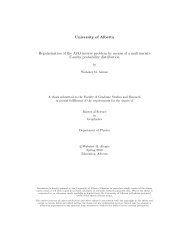Soner Bekleric Title of Thesis: Nonlinear Prediction via Volterra Ser
Soner Bekleric Title of Thesis: Nonlinear Prediction via Volterra Ser
Soner Bekleric Title of Thesis: Nonlinear Prediction via Volterra Ser
You also want an ePaper? Increase the reach of your titles
YUMPU automatically turns print PDFs into web optimized ePapers that Google loves.
3.3. 1-D SYNTHETIC AND REAL DATA EXAMPLES 40<br />
It is clear that the problem is linear in the coefficients. One possible solution vector<br />
is given by the regularized least squares solution (damped least squares). Adopt-<br />
ing the least squares method with zero-order quadratic regularization leads to the<br />
solution <strong>of</strong> the filter coefficients:<br />
m = (A T A) + µI) −1 A T d . (3.29)<br />
For small systems (small order <strong>of</strong> parameters p, q, and r) one can use direct in-<br />
version methods to solve equation (3.29). For systems that involve long operators,<br />
I suggest the use <strong>of</strong> semi-iterative solvers like the method <strong>of</strong> conjugate gradients<br />
(Wang and Treitel, 1973). In our examples, however, I have adopted direct inver-<br />
sion methods. In general, f − x algorithms do not require the inversion <strong>of</strong> large<br />
systems <strong>of</strong> equations. In many cases this is a consequence <strong>of</strong> working with small<br />
spatial windows.<br />
3.3 1-D Synthetic and Real Data Examples<br />
I have developed an algorithm to invert the coefficients <strong>of</strong> a third-order <strong>Volterra</strong><br />
series. I focus on a 1-D synthetic time series which is generated with a real second-<br />
order <strong>Volterra</strong> system. Figures 3.4(a) and 3.5(a) show a 1-D input data for 100<br />
samples.<br />
Figures 3.4(b) and 3.4(c) represent the predicted series modeled <strong>via</strong> the third-<br />
order <strong>Volterra</strong> series (with parameters p = 8, q = 8, and r = 8) and the associated<br />
modeling error, respectively. Figures 3.4(d) and 3.4(e) portray the predicted data<br />
using linear prediction theory and modeling error (p = 8, q = 0, and r = 0). It is









